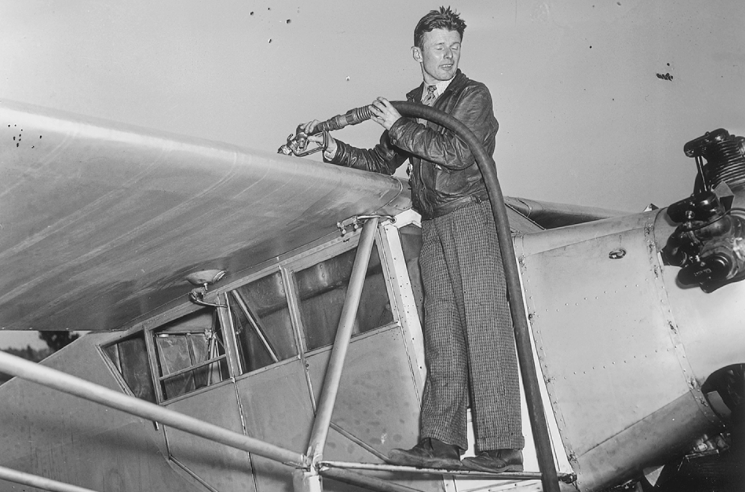The Man Who Went the Wrong Way Into the History Books

On May 21. 1927, Charles Lindbergh and his single-seat Spirit of St. Louis monoplane landed in Paris, France. Approximately 33 hours and 30 minutes prior, Lindbergh had taken off from an airfield on New York’s Long Island; the trip he completed was the first successful solo flight across the Atlantic Ocean. The feat captured hearts and imaginations around the world.
And in the case of Douglas Corrigan, above, imagination was a key ingredient to his success.
Like many people of the time period, Corrigan was enamored with airplanes at a young age. As an 18-year-old in October 1925, he forked over the equivalent of $35 just to experience flight as a passenger—and was immediately hooked by dreams of going into the wild blue yonder himself. He began taking flying lessons and took his first solo flight six months later. And before 1926 was out, he had started a career in aviation, working on the wing and fuel assemblies for The Spirit of St. Louis. When Lindbergh landed, Corrigan was hooked: he wanted to make a transatlantic flight of his own.
Over the next decade, Corrigan kept at it as an airplane mechanic, bouncing from job to job in the San Diego area. After work hours — and yes, with permission — he’d take the company planes out for a brief flight, hoping to become the best pilot he could be. Along the way, he started building a plane of his own. His unique mix of mechanical experience, flight hours logged, and indefatigable gumption allowed him to piece together a plane that he hoped could make the trip across the ocean. In 1935, he made his first application for permission to make the flight, but the regulatory agency at the time denied the request — his plane, while not quite literally made of tape and chewing gum, was in no shape for the journey, they said.
Corrigan didn’t give up, but it didn’t matter; as the Aircraft Owners and Pilots Association recounts, “Corrigan continued to improve and modify his aircraft, but was repeatedly refused the transatlantic permit.” He did, however, obtain a transcontinental one. And, as the New York Times reported, he flew is flying heap of parts from San Diego “to New York on July 10, 1938, setting a solo nonstop record of 27 hours, 50 minutes for the 2,700-mile flight.” The flight, however, was not an easy one — toward the end of the flight, his gas tank sprung a leak, and to make matters worse, the cockpit filled with fumes. But Corrigan proved that the plane — with some more repairs — could definitely fly. So he applied, again, for permission to cross the Atlantic.
About a week later, he received yet another rejection. So he logged a flight plan to return to California. and on July 17th, he departed a New York airfield on his way back to San Diego.
And 28 hours later, he landed. In Ireland.
It’s unclear exactly how that happened. According to multiple sources, Corrigan made a mid-air U-turn; PBS says that “several minutes after takeoff, Corrigan made a complete 180-degree turn and vanished into the clouds towards the Atlantic” and History’s account similarly claims that just after take-off, “he made a 180-degree turn and vanished into a cloudbank to the puzzlement of a few onlookers.” Wikipedia’s entry for Corrigan says otherwise (without citation), “before takeoff, Corrigan asked the manager of Floyd Bennett Field, Kenneth P. Behr, which runway to use, and Behr told him to use any runway as long as he didn’t take off to the west, in the direction of the administration building where Behr had his office.” But either way, Corrigan ended up going east when he should have been going west.
While this probably wasn’t an error on Corrigan’s part, he claimed it was — bad weather and a broken compass were to blame, and while he noticed that he was over water about 26 hours into the flight (about the time he should have been nearing California), it wasn’t like he could just turn around and come back. But it didn’t matter — to the Depression-era folks back home, Corrigan’s ‘error” was a story worth celebrating. As PBS reports, “Corrigan’s adventure captured America’s entrepreneurial spirit and he soon teamed up with companies to market ‘Wrong Way’ goods and memorabilia — such as a watch that ran backwards. He also signed on to write an autobiography and star in a movie about his journey called The Flying Irishman.”
Officially, Corrigan’s stunt didn’t go unpunished. The U.S. regulators either didn’t believe that the flight was an accident or simply didn’t care, and they stripped Corrigan of his pilot’s license when they learned he landed in Ireland instead of California. But even they couldn’t escape the feel-good story, as evidenced by their decision to make the suspension curiously short. Corrigan and his plane made the return trip by boat, and by the time he got back to the United States, the suspension was over. “Wrong Way” Corrigan’s journey landed him in aviation folklore — even if he had to lie to get there.
Bonus fact: Lindbergh’s flight was the first such solo flight, but not the first transatlantic flight in history. That honor goes to two British aviators, John Alcock and Arthur Brown, who made a 19-hour flight from Newfoundland, Canada, to Ireland in 1919 — eight years before Lindbergh. While their feat is often glossed over in favor of Lindbergh’s, Lindbergh himself didn’t overlook their accomplishment. As the BBC reported, when Lindbergh landed in Paris to cheers, he thanked his predecessors, stating “Alcock and Brown showed me the way.”
From the Archives: The story of a transatlantic flight — but for a very small plane.
